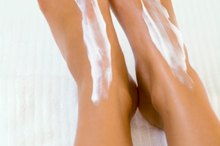Symptoms of Infantigo
Infantigo, more commonly known as impetigo, is a skin infection caused by a staphylococcus (staph) bacterial infection. The contagious form of the infection can be caused by staph or streptococci (strep) bacteria. The bacteria infection is characterized by skin blisters and lesions. Impetigo is most common in children.
Causes
Impetigo is caused by bacteria entering the skin through an open wound or insect bite. Bacteria lives on skin naturally, but can cause an infection once skin has broken. Once the bacteria is inside the body, it produces a toxin that splits the skin open and causes the rash seen with the infection. This broken skin is the first symptom of the disease.
- Impetigo is caused by bacteria entering the skin through an open wound or insect bite.
- Once the bacteria is inside the body, it produces a toxin that splits the skin open and causes the rash seen with the infection.
Rash Location
Symptoms of an MRSA Infection on the Face
Learn More
Imeptigo can cause a rash anywhere on the body, but typically it is seen on the face. Around the nose and mouth is the most common place for the rash to occur.
Red Sore Stage
The first stage of the impetigo skin rash begins as a discolored red sore. If the case is the contagious form, the red area will typically begin 4 to 10 days after being exposed.
Blister Stage
What Is the Difference Between Cellulitis & Mrsa?
Learn More
The red sore will later develop fluid-filled blisters. The blisters are very thin and rupture easily. The blisters will also ooze and weep. The fluid inside the blisters is straw-colored.
- The red sore will later develop fluid-filled blisters.
- The blisters are very thin and rupture easily.
Crust Stage
The rash forms a honey colored crust as it dries up and goes away. The rash can be quite itchy, and can be mildly painful. A fever does not normally accompany this infection.
Improvement of Rash Symptoms
The impetigo rash will begin to go away once it is treated with antibiotics, and it does not normally leave any scars on the skin.
Related Articles
References
- Centers for Disease Control and Prevention. Impetigo. Updated May 29, 2020.
- Hartman-adams H, Banvard C, Juckett G. Impetigo: diagnosis and treatment. Am Fam Physician. 2014;90(4):229-35.
- Peppard WJ, Daniels A, Fehrenbacher L, Winner J. Evidence based approach to the treatment of community-associated methicillin-resistant Staphylococcus aureus. Infect Drug Resist. 2009;2:27–40. doi:10.2147/idr.s3794
- Creech CB, Al-Zubeidi DN, Fritz SA. Prevention of Recurrent Staphylococcal Skin Infections. Infect Dis Clin North Am. 2015;29(3):429–464. doi:10.1016/j.idc.2015.05.007
- American Academy of Dermatology Association. Impetigo: diagnosis and treatment.
- National Institute of Diabetes and Digestive and Kidney Diseases. Glomerular diseases. Updated April 2014.
Writer Bio
Abigail Adams began her freelance writing career in 2009, teaching others about medical conditions and promoting wellness by writing on online health and fitness publications. She is educated and licensed as a registered nurse, having received her degree from North Georgia College and State University.








